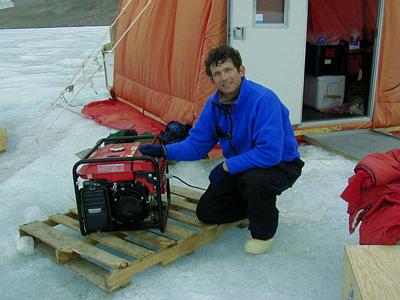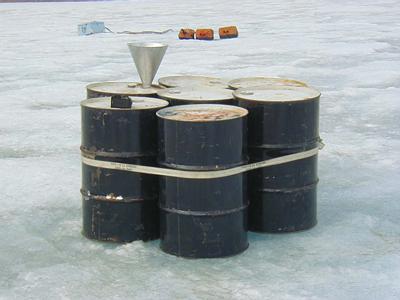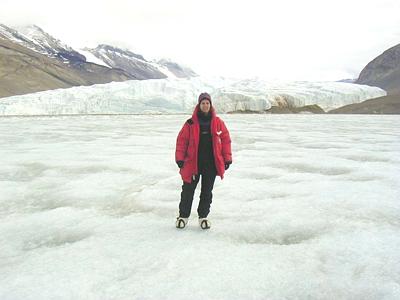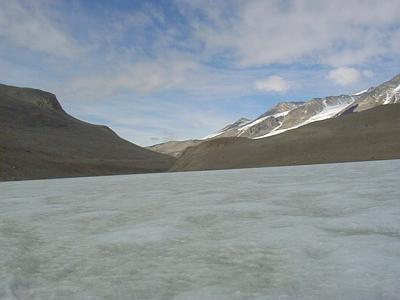17 November, 1999
West Lake Bonney, Taylor Valley, Antarctica Wednesday
I noticed that on yesterday's journal I had written "Monday" when it was
really Tuesday! I get so confused when there is no distinction between day
and night!
An absolutely amazing day! Today was a day of 'firsts'. In the morning, I
had my first ride on a helicopter! Julie and I were petrified until we
lifted off the ground. It was like riding a roller coaster without the
quick turns! Our pilot, John, was very nice and didn't do anything to scare
us. The National Science Foundation helicopters are operated by PHI, a
company based in the Gulf of Mexico. They are accustomed to operating
around oilrigs. Julie tells me that now she wants to become a licensed
helicopter pilot! So much for getting over the fear! I don't think I'm
ready to do that yet, but I am more comfortable now and it was a lot of fun!
We rode in the helo for 54 miles to Lake Bonney in the Dry Valleys, Taylor
Valley, specifically. This was my first glimpse of glaciers up close and my
first site of the Dry Valleys. What a spectacular place! Lake Bonney sits
in a valley with Taylor Glacier at the west end and numerous other glaciers
sliding down the hillsides! It was a view that I will not soon forget!
Lake Bonney is only one of several lakes in this parcticular valley. It is a
large, permanently ice-covered lake and is separated into two parts called
lobes. Think of a figure 8. Lake Bonney is similar in that there is a west
lobe and an east lobe that are separated by a shallow, narrow sill. Today,
we landed on the ice near Taylor Glacier on the west lobe of the lake.
Now for some of the science! Another group had already drilled holes
through the 4 meters of ice for us and had erected a weather hut. Inside
the hut, we assembled our gear, including the trace-metal clean box, our
sampling bottles and bags, the measured tubing so we would now at what depth
we were taking samples, the generator to run the pumps to pump the water,
and of course, the food! At six different depths (from 3 meters to 25
meters) we filled a bottle to test for chlorophyll (should only be present
in the layers receiving light), nutrients (such as nitrates and nitrites),
bacterial samples (for types and numbers of bacteria present), our sampling
bags for our denitrification experiments, and a sample that measured the
temperature and salinity of the lake. I even tasted it! I made a horrible
face because it was so salty and fizzed in my mouth! The water was about 3
degrees Celsius on average and the salinity ranged from slightly saline to
off-the-chart saline! The deeper we sampled, the more saline the sample
became.
My final 'first' came when Julie fed me a cracker with sardines on it! I
told you she always gets me to eat weird food! It was very salty and I
actually liked it!
At 5 p.m. a Kiwi helicopter picked us up. Their helicopter was different
from the one in which we arrived. The Kiwi helicopter was an Iroquois, a
Viet Nam War vintage helo. The New Zealand Air Force operates these helos
and they are more apt to scare you when you ride! The pilot, Jason, liked
to ride very close to the hillside and swoop down as you crossed a peak! It
was fun, but scary!
Our work had only begun for the day! After supper, we had to process the
samples. The sampling bags were weighed, a trace-metal clean room was
built, and acetylene was added to each of the sampling bags. I'll explain
this part of the experiment in a later journal. Maite worked until 1 a.m.
filtering chlorophyll samples! Tomorrow we will begin testing the samples
for the presence of nitrous oxide, an indicator that denitrification is
occurring.
Answer to yesterday's question: The air is so dry in the Dry Valleys that
any snow in the atmosphere immediately evaporates (sublimates). That is, it
goes from a solid to a gas without ever passing through a liquid phase.
Today's question: Who first described the Dry Valleys? HINT: It was a
famous polar explorer!
Polar Profile: Quien es Maite Maldonado? La chica que llama a Sharon,
"Charo". Dr. Maria Teresa Maldonado Pareja is a a Ph.D scientist working
with Dr. Mark Wells and Dr. Bess Ward. Maria is better known as "Maite",
which means, beloved or dear one.
Maite is from Grenada, Spain and came to the U.S. to attend Verde Valley
School in Arizona for her final year of high school. She stayed in the U.S.
for her undergraduate degree in biology/marine biology, graduating from
Smith College in Massachusetts in 1991. Maite took it a break from school,
living for awhile in New York City and traveling through Central and South
America. In 1992, Maite moved to Montreal, Canada to study at McGill
University under the guidance of Dr. Neil M. Price. Her dissertation, "Iron
Acquisition By Marine Phytoplankton" earned her a Ph.D. Today, Maite works
for both Dr. Wells and Dr. Ward in Maine and Princeton, respectively. Maite
is an avid mountain biker and enjoys cross-country sking. She listens to
opera in the laboratory and is our expert when it comes to good food! Maite
is quite a gourmet! Maite and Julie, yesterday's polar profile, are best
friends.
Sharon
JUST FOR KIDS!!!!! I noticed that on yesterday's journal I had written
"Monday" when it was really Tuesday! I get so confused when there is no
difference between day and night!
An absolutely amazing day! Today was a day of 'firsts'. In the morning, I
had my first ride on a helicopter! Julie and I were very scared until we
lifted off the ground. It was like riding a roller coaster without the
quick turns! Our pilot, John, was very nice and didn't do anything to scare
us. Julie has decided that now she wants to become a licensed helicopter
pilot!
We flew in the helicopter to Lake Bonney, which is in the Taylor Valley, one
of the Dry Valleys. This was the first time I got to see a glacier up close
and the first time I ever saw the Dry Valleys. We landed right on the
frozen surface of the lake! The lake is covered with 4 meters of ice! Get
a meter stick and measure 4 meters in you school hallway to see how thick
the ice is! Fortunately, a hole had already been drilled for us! We took
water samples at different depths in the water. We measured the temperature
and how salty the water was. I even tasted it! I made a horrible face
because it was so salty and fizzed in my mouth! The temperature was about 3
degrees Celsius.
Answer to yesterday's question: The air is so dry in the Dry Valleys that
any snow in the atmosphere immediately evaporates. That is, it goes from a
solid to a gas without ever becoming a liquid. Think about melting an ice
cube and heating it until it boils. The solid ice melts to become liquid
water. The liquid water gets so hot that it becomes steam. In the Dry
Valleys, the solid ice (or snow) does not become liquid. Because of the dry
air, the solid goes straight to a gas.
Today's question: Who first saw the Dry Valleys and told the world about
them? HINT: It was a famous polar explorer!
Polar Profile: Quien es Maite Maldonado? La chica que llama a Sharon,
"Charo". Dr. Maria Teresa Maldonado Pareja is better known as "Maite", which
means, beloved or dear one.
Maite is from Grenada, Spain and came to the U.S. for her final year of high
school. She stayed in the U.S. for college. She studied biology at Smith
College in Massachusettes. In 1992, Maite moved to Montreal, Canada to study
at McGill University where she earned her Ph.D. Today, Maite works for both
Dr. Wells and Dr. Ward. Maite likes mountain biking and enjoys
cross-country skiing. She listens to opera in the laboratory and is our
expert when it comes to good food! Maite is quite a gourmet! Maite and
Julie, yesterday's polar profile, are best friends.
Sharon

Mark working with the generator that operated our pumping system.

Gray water barrels on the ice at Lake Bonney. Water removed from the lake and not used for sampling, is put into these barrels. No water should ever be added to the lake.

Sharon standing on the permanent ice cover of Lake Bonney. Taylor Glacier, visible in the background, is about a 20 minute walk.

View of Taylor Valley.

Maria "Maite" Maldonado working in the laboratory at Crary Lab.

A Kiwi Iroquios comes to pick us up. The Helicopter is over Taylor Glacier at the west end of Taylor Valley.

Contact the TEA in the field at
.
If you cannot connect through your browser, copy the
TEA's e-mail address in the "To:" line of
your favorite e-mail package.
|
